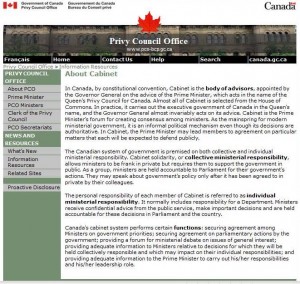How to Write Summaries
THE PURPOSE
This purpose of this note is to demonstrate how to summarize a 300-word article called About Cabinet. It was prepared by the Privy Council Office (PCO) which provides advice and support to the Prime Minister and Cabinet. Read the PCO article, summarize it and then compare your summmary with the examples below.
THE CONTEXT
Remember, as a public sector writer, you will repeatedly hear you need to be more succinct and brief. You’ll have to summarize 100 page Memoranda to Cabinet (MCs) into one or two page briefing notes. You’ll write Question Period (QP) speaking points that include background information, all on one page. The ability to summarize is a critical skill and like any other, it can be mastered with practice. Look for opportunities to summarize (do it with the TV program plot, the newspaper article, your friend’s phone call and so on). The fewer words you use, the more challenging summarizing can be. It will, however, bring rigour to your thinking, if you practice capturing the essence in less than 25 words. The technique involves isolating the key points; the subject and predicate phrases and eliminating extraneous words. Ask yourself what is this about, if I were to describe it in one sentence?
THE EXAMPLES
About Cabinet: 25 word summary
Ministers must collectively demonstrate solidarity and individually manage their departments. The Cabinet system supports the Prime Minister’s leadership role and ministerial debates on government priorities.
About Cabinet: 50 word summary
Cabinet is the executive branch. Ministers can disagree in private but collective cabinet solidarity requires them to support the government publically. Ministers have individual responsibility for a Department. The Cabinet system secures ministerial agreement on priorities; provides a forum for debate on decisions; and supports the Prime Minister’s leadership role.
About Cabinet: 100 word summary
Cabinet, as the executive branch of government, is based on collective and individual ministerial responsibility. Collective responsibility enables ministers to be frank in private but cabinet solidarity requires them publically to support the government. Individual ministerial responsibility normally includes responsibility for a Department. Ministers receive advice from the public service, make decisions and are held accountable by Parliament and the public.
The Cabinet system secures agreement among ministers on government priorities and parliamentary actions; provides information and a forum for debate on decisions ministers will be collectively and individually held responsible for; and supports the Prime Minister’s leadership role.
About Cabinet: 300 word article posted on the PCO website
In Canada, by constitutional convention, Cabinet is the body of advisors, appointed by the Governor General on the advice of the Prime Minister, which acts in the name of the Queen’s Privy Council for Canada. Almost all of Cabinet is selected from the House of Commons. In practice, it carries out the executive government of Canada in the Queen’s name, and the Governor General almost invariably acts on its advice. Cabinet is the Prime Minister’s forum for creating consensus among ministers. As the mainspring for modern ministerial government, it is an informal political mechanism even though its decisions are authoritative. In Cabinet, the Prime Minister may lead members to agreement on particular matters that each will be expected to defend publicly.
The Canadian system of government is premised on both collective and individual ministerial responsibility. Cabinet solidarity, or collective ministerial responsibility, allows ministers to be frank in private but requires them to support the government in public. As a group, ministers are held accountable to Parliament for their government’s actions. They may speak about government’s policy only after it has been agreed to in private by their colleagues.
The personal responsibility of each member of Cabinet is referred to as individual ministerial responsibility. It normally includes responsibility for a Department. Ministers receive confidential advice from the public service, make important decisions and are held accountable for these decisions in Parliament and the country.
Canada’s cabinet system performs certain functions: securing agreement among Ministers on government priorities; securing agreement on parliamentary actions by the government; providing a forum for ministerial debate on issues of general interest; providing adequate information to Ministers relative to decisions for which they will be held collectively responsible and which may impact on their individual responsibilities; and providing adequate information to the Prime Minister to carry out his/her responsibilities and his/her leadership role.
_______________________________________________________________________________________________________________________________________
The document you are currently reading is also available in pdf format. Click on the link to access the pdf on How to Write Summaries.
_______________________________________________________________________________________________________________________________________
